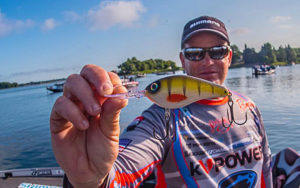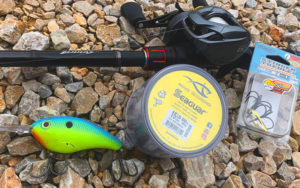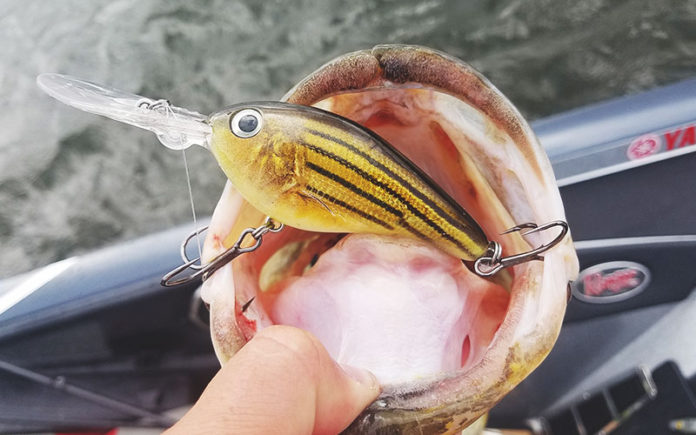The crankbait lure category is one of the most popular in all freshwater fishing, especially when it comes to bass fishing. They come in different sizes, shapes, and with different wobbling actions. They are fine-tuned to reach depths from a foot below the surface to thirty feet or more.
Noted crankbait guru Keith Combs and veteran professional bass angler Shaw Grigsby share some of their wisdom for maximizing the effectiveness of crankbaits to dive shallower and deeper and trigger more bites.
The importance of casting distance
As a simple explanation, the farther you cast, the deeper your crankbait will dive. It’s simple physics and having a crankbait get down to the maximum depth will keep your bait at that depth for a longer period. Combs says that’s a significant benefit, but he also sees other reasons why a long cast for deep-diving crankbaits is essential.
“Getting maximum depth is the biggest reason you want to make a long cast and the longer cast will also allow you to cover more water,” he says. “I like to position my boat as far away from fish as I can when cranking because the further you can stay away from fish, the better. Another benefit to a longer cast is that when you hook one further away, the fish wears itself out by the time it gets right next to the boat and that’s where you lose most of the fish hooked with treble hooks, so it increases your landing ratio as well.”
Both Combs and Grigsby make sure to have the right rod, reel, and line to maximize their casting distance.
“I like a rod that is at least 7-foot, 2-inches and up to 7-11,” and I also like a fiberglass rod,” says Combs. “The fiberglass rod loads up better and helps with your cast. It’s also important to have a reel with a larger line capacity to hold the line you need. I like InvizX because it is such a smooth line and it makes it easy to make those long casts.”
Grigsby uses the same reasoning for selecting gear for longer casts but will also purposely make shorter casts at times to affect the diving distance of his crankbaits.
“Just like a longer cast makes it dive deeper, I’ll do the opposite and make short casts so it won’t dive down as far,” Grigsby says. “Even with a deep diving crankbait like a Strike King 6XD, you can make short little pitches along dock pilings and the bait will get down quick but won’t hit bottom. I’ll also do that to fish above grass.”
Preferred pound tests
When it comes to pound tests, crankbait fishermen generally select lines in the 10- and 12-pound range, and Grigsby sticks with the norm, while Combs goes even heavier.

“I use 15-pound InvizX for almost all of my crankbait fishing,” says Combs. “It sounds big for crankbaits, but if you look at the actual diameter, it’s not much thicker than the ten pound monofilament that we all used to crank with back in the day. I like that it is small enough to get a good casting distance but still strong enough that I can fight a fish aggressively to get them in.”
As one of the top crankbait anglers in the world, Combs has several top-level wins thanks to a crankbait. As a result, he’s often asked what line he recommends.
“I always recommend InvizX and it’s my favorite crankbait line because of how manageable it is,” he says. “When fishing a crankbait all day long, no matter what line you are using, it’s going to take some abuse if you are fishing around cover and catching fish. It’s a technique that requires you to change line constantly, and I think InvizX is a great value for the performance.”
Grigsby is also a fan of InvizX, with 10- or 12-pound tests being his go-to sizes.
“Twelve-pound is my standard, and I feel confident that I can grind on the fish and get them into the boat,” he says. “Seaguar lines have a very thin diameter compared to other brands, but it’s also very strong, so I’m real comfortable with 12 pound and love how well it casts. I’ll move to 10 pound if I want the bait to dive a shade deeper and 15 if I want it to dive a little shallower.”
Affecting diving depths of crankbaits
In Grigsby’s early days as a professional angler, monofilament was the only choice for fishing line. With the advancement of fluorocarbon, along with different crankbait materials, things have changed for the better, in his opinion.

“In the old days, we were cranking balsa crankbaits on monofilament and it was a real chore to dial in the right diving depth and to get them to dive deeper,” he says. “Seaguar fluorocarbon has been a real difference maker because it sinks and casts so much better. Plus, the crankbaits are all plastic and built to reach specific depths. Besides casting distance, I’ll also experiment with different pound test lines and modify my hooks to heavier hooks if I want the bait to dive just a tad bit deeper.”
Combs keeps it simple when wanting a bait like a squarebill to dive to different levels and the only thing he will change is his rod position.
“The easiest way to affect the diving depths of your bait is to move your rod,” he said. “Holding your rod up at the beginning of your cast will greatly change how deep the bait dives. That’s the simplest way to control depth, and I prefer that instead of changing line size because changing your line size will change the bait’s action. When I’m burning a squarebill, I believe 15-pound InvizX gives it the best deflection when it hits the cover.”
In many respects, crankbaits are a basic and simple lure in that it can catch fish just by casting and retrieving, but like everything else in fishing, there are little tricks to change their actions and diving depths. Top bass professionals Keith Combs and Shaw Grigsby have learned that crankbaits can do even more with some adjustments to improve their effectiveness.




